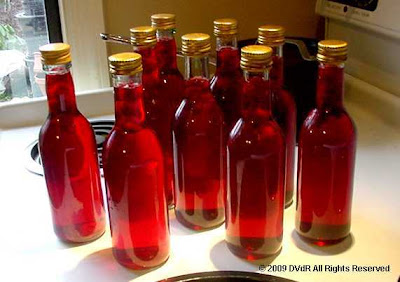
Due to the excessive amounts of rain lately, I’m picking a few more red raspberries than I really expected, after so many canes were lost when a maple tree fell on the patch destroying most of the mature canes earlier this year.
I’m picking only about a cup a day; even so, I still won't harvest many berries. Next year the new canes from this summer should produce at least a quart a day, maybe even half a gallon daily! With so few red raspberries, I won’t have enough to make my favorite Peach Melba Jam. The jam is easy: fresh peaches and raspberries. Since my older family members cannot eat anything with small seeds, I juice the raspberries and use the juice straight in place of whole berries.
The taste is reminiscent of Peach Melba although the original recipe was raspberry sauce and fresh peaches over vanilla ice cream, developed by a French chef in London to honor the Australian soprano, Dame Nellie Melba around 1892. (You can deliberately make Peach Melba Jam thinner, to make a sauce for ice cream.)
I should have enough raspberries to make a small batch of raspberry vinegar. I love a splash of raspberry vinegar on green salads, and also on lightly steamed veggies. It is especially good splashed over a chiffonade of baby Brussels sprouts lightly sautéed in butter until just barely tender.
Raspberry Vinegar
To make raspberry vinegar, I start with a base of champagne vinegar. You could use white wine vinegar but I think the champagne vinegar is slightly more subtle. To a quart of vinegar, I add about a quart of raspberries over low heat, and barely warm them, just until the mash starts to give off a little steam. (I mash the berries with the back of a wooden spoon while they are starting to heat.) Be sure to use a non-reactive pan!
Put the whole cooked mash into a jelly bag and let drip overnight. I generally use 2-3 layers of butter muslin in place of a jelly bag. Do not squeeze the straining bag or your vinegar will be cloudy. After it has drained overnight, toss the pulp and re-heat the juice to about 150ºF just to be sure you didn’t pick up unwanted airborne bacteria overnight. Pour into sterilized bottles. (I generally taste mine before bottling, adding more vinegar if the raspberry taste is too overpowering. I seldom need to add any, depending on the berries that year.)
 Save several whole raspberries to place in the bottom of the bottles for decoration, if you so desire. I use 8 oz. glass bottles, as a little raspberry vinegar lasts a long time. Cap, and store in a cool, dark place. It is ready to use immediately and will store for a year or more.
Save several whole raspberries to place in the bottom of the bottles for decoration, if you so desire. I use 8 oz. glass bottles, as a little raspberry vinegar lasts a long time. Cap, and store in a cool, dark place. It is ready to use immediately and will store for a year or more.The hill out back has wild black raspberries, but it has been too wet to climb the hill to see if they are ready to pick. The wild blackberries farther up the hill should produce abundantly later this year, thanks to a cool (no frost) Blackberry Winter, which they need to set fruit, followed by plenty of spring rain. I will make my much-requested Wild Blackberry Savory (jelly).
On the plate with the raspberries in the first photo above are a few black currants. Last year the plants were new to my garden, and before I could pick them in sprigs, the birds got them. So I’m picking a few this year as they are ready. I won’t have many this year either since I recently transplanted the bushes again, to be next to my new red currants. I hope to pick enough black currants to use in a scone recipe.
No comments:
Post a Comment
I'd love to hear what you think about my posts! We all learn together.